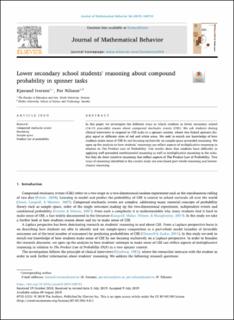Lower secondary school students’ reasoning about compound probability in spinner tasks
Peer reviewed, Journal article
Published version
Permanent lenke
https://hdl.handle.net/11250/2657724Utgivelsesdato
2019Metadata
Vis full innførselSamlinger
Originalversjon
Iversen, K. & Nilsson, P. G. (2019). Lower secondary school students’ reasoning about compound probability in spinner tasks. Journal of Mathematical Behavior, 56: 100723. doi: 10.1016/j.jmathb.2019.100723Sammendrag
In this paper we investigate the different ways in which students in lower secondary school (14–15 year-olds) reason about compound stochastic events (CSE). We ask students during clinical interviews to respond to CSE-tasks in a spinner context, where two linked spinners display equal or different sizes of red and white areas. We seek to enrich our knowledge of how students make sense of CSE by not focusing exclusively on sample-space grounded reasoning. We open up the analysis to how students’ reasoning can reflect aspects of multiplicative reasoning in relation to The Product Law of Probability. Our results show that students have difficulty in applying well-grounded combinatorial reasoning as well as multiplicative reasoning to the tasks, but they do show intuitive reasoning that reflect aspects of The Product Law of Probability. Two ways of reasoning identified in the current study are area-based part-whole reasoning and lowest-chance reasoning.

